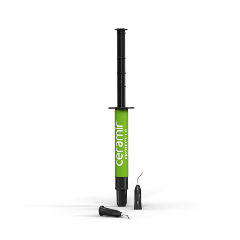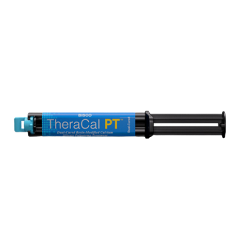Testing the Tools: Pulpal Liners
Pulpal liners are critical parts of conservative dentistry, and the chemistry backing them up is phenomenal. Depending on your personal experience and affiliation, you likely already have a quality product in your armamentarium. But, if you haven’t reevaluated the market recently, these are some of the top brands to consider.
Flowable and Dense Makes a Winner
 Ceramir® Protect LC
Ceramir® Protect LC
Ceramir®
ceramirdental.com
Ceramir® Protect LC is a newer product on the market and is based on the chemistry involved with the company’s successful bioceramic cement. Unlike the cement, the Ceramir Protect LC does not need to be triturated to be activated and is supplied in a simple-to-use single-barrel tube. After cavity preparation, place the material directly into the area that you suspect is in closest proximity to the pulp chamber, and then light cure. This liner has a creamy consistency and flows easily but has enough density to hold onto whatever wall you place it on. Indicated for direct and indirect pulp capping, this liner promotes the formation of hydroxyapatite by maintaining a high alkaline pH and releasing calcium steadily. I have not used it in direct pulp capping situations, but I have used it for indirect capping and have had only good reports from patients with deep excavations regarding minimal postoperative sensitivity. Similar to other composite-type pulpal liners, this material is radiopaque and insoluble and is a bright white color to help differentiate it from the overlaying composite layers in case of future excavation.
A Great Choice for Pediatric Pulpotomies
 TheraCal PT®
TheraCal PT®
Bisco
bisco.com
TheraCal® by Bisco has been a longtime pulpal lining product, but the company continues to improve and expand its offerings. What once was a single product is now a family of products that all have great bioactivity. TheraCal PT (pulp therapy) is a dual-cured material that comes in a small double-barrel syringe. Instead of using IRM® or calcium hydroxide, my preference is to use TheraCal PT for pediatric pulpotomies or direct pulp caps. The proprietary tricalcium silicate filler particles are mixed into a hydrophilic monomer so they work well in the presence of blood, but you should definitely achieve some level of hemostasis prior to application. Setting time is typically around 1.5 minutes when not light-cured. The filler particle composition allows a high release of calcium and creates a high-alkaline pH that, in company studies, measured at 11.5 after seven days. This chemistry promotes formation of hydroxyapatite and secondary and tertiary dentin while inhibiting bacterial activity and infiltration. At this point, I’ve had equivalent results compared with calcium hydroxide and with significantly easier placement.
Ready for Deep Preparations
.tmb-medium.png?Culture=en&sfvrsn=7d6d7c47_1) Activa™ BioACTIVE Base/Liner and Restorative
Activa™ BioACTIVE Base/Liner and Restorative
Pulpdent®
pulpdent.com
Pulpdent® is another longtime producer of bioactive dental materials, and a great example of this is the Activa™ BioACTIVE Base/Liner. Like the TheraCal products, the same basic chemistry has been used to create an array of products for most restorative dentistry needs. The Activa BioACTIVE materials are hydrophilic and reactive to pH changes to allow for greater or lesser release of fluoride, phosphate and calcium ions when needed. The Activa Liner in particular has far less water absorption than glass ionomers, so it will remain adhered and flexurally strong. The Liner and most Activa products are dual-cured, so they will work well with deep preparations and help to create new hydroxyapatite in proximity to the pulp even if the curing light cannot reach them. Even without a bonding agent, the bond strength and minimal marginal leakage make this material a safe choice. The regular Activa restorative gun can be a little bulky, but the liner is in a small, easyto-use double barrel. In deep situations where I once would have placed a glass ionomer as an interim restoration, I’m now placing Activa Liner and Restorative simultaneously as long-term permanent restorations.
Ross Isbell, DMD, MBA, currently practices in Gadsden, Alabama, with his father, Gordon Isbell, DMD, MAGD. He attended the University of Alabama at Birmingham (UAB) School of Dentistry and completed a general practice residency at UAB Hospital. Isbell has confirmed to AGD that he has not received any remuneration from the manufacturers of the products reviewed or their affiliates for the past three years. All reviews are the opinions of the author and are not shared or endorsed by AGD Impact or AGD. To comment on this article, email impact@agd.org.
Flowable and Dense Makes a Winner
 Ceramir® Protect LC
Ceramir® Protect LCCeramir®
ceramirdental.com
Ceramir® Protect LC is a newer product on the market and is based on the chemistry involved with the company’s successful bioceramic cement. Unlike the cement, the Ceramir Protect LC does not need to be triturated to be activated and is supplied in a simple-to-use single-barrel tube. After cavity preparation, place the material directly into the area that you suspect is in closest proximity to the pulp chamber, and then light cure. This liner has a creamy consistency and flows easily but has enough density to hold onto whatever wall you place it on. Indicated for direct and indirect pulp capping, this liner promotes the formation of hydroxyapatite by maintaining a high alkaline pH and releasing calcium steadily. I have not used it in direct pulp capping situations, but I have used it for indirect capping and have had only good reports from patients with deep excavations regarding minimal postoperative sensitivity. Similar to other composite-type pulpal liners, this material is radiopaque and insoluble and is a bright white color to help differentiate it from the overlaying composite layers in case of future excavation.
A Great Choice for Pediatric Pulpotomies
 TheraCal PT®
TheraCal PT®Bisco
bisco.com
TheraCal® by Bisco has been a longtime pulpal lining product, but the company continues to improve and expand its offerings. What once was a single product is now a family of products that all have great bioactivity. TheraCal PT (pulp therapy) is a dual-cured material that comes in a small double-barrel syringe. Instead of using IRM® or calcium hydroxide, my preference is to use TheraCal PT for pediatric pulpotomies or direct pulp caps. The proprietary tricalcium silicate filler particles are mixed into a hydrophilic monomer so they work well in the presence of blood, but you should definitely achieve some level of hemostasis prior to application. Setting time is typically around 1.5 minutes when not light-cured. The filler particle composition allows a high release of calcium and creates a high-alkaline pH that, in company studies, measured at 11.5 after seven days. This chemistry promotes formation of hydroxyapatite and secondary and tertiary dentin while inhibiting bacterial activity and infiltration. At this point, I’ve had equivalent results compared with calcium hydroxide and with significantly easier placement.
Ready for Deep Preparations
.tmb-medium.png?Culture=en&sfvrsn=7d6d7c47_1) Activa™ BioACTIVE Base/Liner and Restorative
Activa™ BioACTIVE Base/Liner and RestorativePulpdent®
pulpdent.com
Pulpdent® is another longtime producer of bioactive dental materials, and a great example of this is the Activa™ BioACTIVE Base/Liner. Like the TheraCal products, the same basic chemistry has been used to create an array of products for most restorative dentistry needs. The Activa BioACTIVE materials are hydrophilic and reactive to pH changes to allow for greater or lesser release of fluoride, phosphate and calcium ions when needed. The Activa Liner in particular has far less water absorption than glass ionomers, so it will remain adhered and flexurally strong. The Liner and most Activa products are dual-cured, so they will work well with deep preparations and help to create new hydroxyapatite in proximity to the pulp even if the curing light cannot reach them. Even without a bonding agent, the bond strength and minimal marginal leakage make this material a safe choice. The regular Activa restorative gun can be a little bulky, but the liner is in a small, easyto-use double barrel. In deep situations where I once would have placed a glass ionomer as an interim restoration, I’m now placing Activa Liner and Restorative simultaneously as long-term permanent restorations.
Ross Isbell, DMD, MBA, currently practices in Gadsden, Alabama, with his father, Gordon Isbell, DMD, MAGD. He attended the University of Alabama at Birmingham (UAB) School of Dentistry and completed a general practice residency at UAB Hospital. Isbell has confirmed to AGD that he has not received any remuneration from the manufacturers of the products reviewed or their affiliates for the past three years. All reviews are the opinions of the author and are not shared or endorsed by AGD Impact or AGD. To comment on this article, email impact@agd.org.
